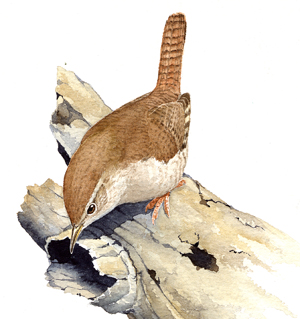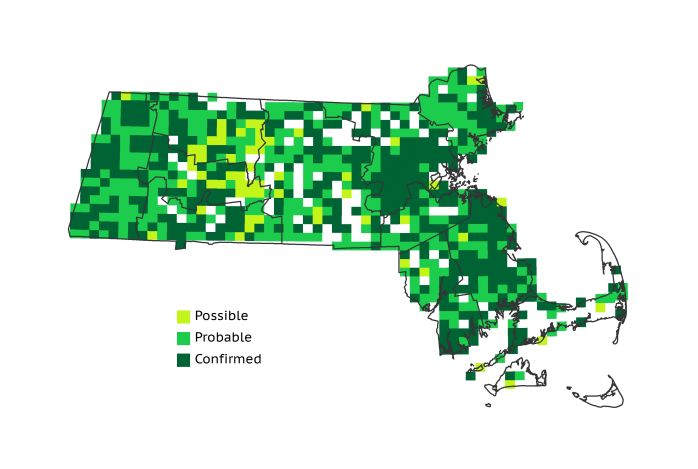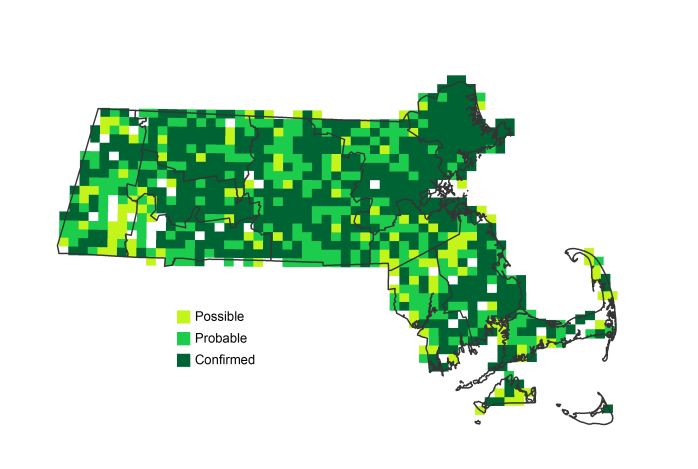Find a Bird
House Wren
Troglodytes aedon

Nearly ubiquitous and stable
Action/monitoring needed
“It is sprightly, active, vigilant, and courageous.” – John James Audubon, Birds of America
House Wrens have never been shy about making their homes alongside those of humans. These familiar birds can be heard boisterously singing in forests, fields, and towns throughout the Commonwealth. They can also often be seen prowling around the margins of forest clearings and backyard gardens, tails cocked and ever alert for their invertebrate prey. Though they apparently suffered a decline near the beginning of the twentieth century, they seem to have made a vigorous recovery in their breeding footprint. Recent analyses of their abundance, however, tell a different tale.
Historic Status
William Peabody wrote with praise of the spirited little House Wren, “It has many quarrels with other birds,” he said, “and, small as it is, maintains its rights and perhaps something more” (Peabody 1839). This common little bird, as familiar as any other in the state, soon met its match. During the last quarter of the nineteenth century, the introduced House Sparrow began to wage war against the House Wren – a war that the wrens were ill-equipped to win. By the early twentieth century, Edward Howe Forbush described House Wrens as “doomed to give way” to the House Sparrow (Forbush 1907). From 1917 onward, however, the tide turned and House Wrens began a comeback. By the 1930s, they had triumphed, or at least found common ground with the House Sparrows, and reestablished themselves as breeders across Massachusetts (Forbush 1929).
Atlas 1 Distribution
The distribution of House Wrens in Atlas 1 showed almost complete occupancy of the Berkshire Highlands and every region west of there, and overall they occupied 80% of the state. The Berkshire Transition zone and Connecticut River Valley were also heavily occupied, although there were a few small gaps. Through the Worcester and especially the Lower Worcester Plateau, there were small but noticeable gaps in the House Wren’s distribution, particularly around the city of Worcester, where House Sparrows and European Starlings were likely more numerous, and may have challenged House Wrens for nesting cavities. House Wrens were widespread in the Coastal Plains, though their distribution was somewhat patchy in the southwestern and northwestern parts of the region. They were also a common sight in the Boston Basin, save for Boston proper and the offshore islands. Breeding wren activity was recorded in 86% of Bristol/Narragansett Lowland blocks, but in only 40% of the Cape and Islands blocks.
Atlas 2 Distribution and Change
House Wrens occupied 86% of the state overall in the second Atlas, and using the effort-controlled blocks they showed a 6% gain statewide. They also reflected a net growth in percent of blocks occupied throughout much of the state with the exception of the Taconics, Berkshire Highlands, Lower Berkshire Hills, and Berkshire Transition. This growth was accomplished by persisting in blocks already occupied during Atlas 1, augmented by a spread into new blocks. The reasons for small regional declines are not known, although the New York Breeding Bird Atlas 2 also shows House Wrens to be sparsest at the highest elevations (McGowan & Corwin 2008). Their colonization of the Cape, Martha’s Vineyard, and Nantucket was particularly noteworthy.
Atlas 1 Map

Atlas 2 Map

Atlas Change Map

Ecoregion Data
Atlas 1 | Atlas 2 | Change | ||||||
Ecoregion | # Blocks | % Blocks | % of Range | # Blocks | % Blocks | % of Range | Change in # Blocks | Change in % Blocks |
Taconic Mountains | 16 | 100.0 | 2.1 | 13 | 52.0 | 1.5 | -4 | -26.7 |
Marble Valleys/Housatonic Valley | 39 | 100.0 | 5.0 | 39 | 100.0 | 4.4 | 0 | 0.0 |
Berkshire Highlands | 54 | 98.2 | 7.0 | 50 | 90.9 | 5.6 | -5 | -9.4 |
Lower Berkshire Hills | 28 | 100.0 | 3.6 | 23 | 74.2 | 2.6 | -5 | -18.5 |
Vermont Piedmont | 16 | 94.1 | 2.1 | 17 | 100.0 | 1.9 | 0 | 0.0 |
Berkshire Transition | 33 | 86.8 | 4.3 | 32 | 80.0 | 3.6 | -4 | -12.9 |
Connecticut River Valley | 52 | 92.9 | 6.7 | 59 | 90.8 | 6.6 | 3 | 6.3 |
Worcester Plateau | 66 | 84.6 | 8.5 | 85 | 96.6 | 9.5 | 5 | 10.4 |
Lower Worcester Plateau | 60 | 81.1 | 7.8 | 74 | 92.5 | 8.3 | 3 | 5.6 |
S. New England Coastal Plains and Hills | 222 | 82.2 | 28.7 | 274 | 96.8 | 30.6 | 26 | 11.5 |
Boston Basin | 42 | 75.0 | 5.4 | 50 | 89.3 | 5.6 | 7 | 12.7 |
Bristol and Narragansett Lowlands | 91 | 85.8 | 11.8 | 96 | 84.2 | 10.7 | 2 | 2.0 |
Cape Cod and Islands | 55 | 40.4 | 7.1 | 84 | 58.3 | 9.4 | 21 | 17.5 |
Statewide Total | 774 | 79.9 | 100.0 | 896 | 86.4 | 100.0 | 49 | 5.9 |
Notes
The House Wren shows a significant decreasing Breeding Bird Survey (BBS) trend in Massachusetts and in the New England/Mid-Atlantic Region. It falls into our “whispering bird” category – those species with a demonstrated stable or increasing breeding footprint from Atlas 2 data, but also a demonstrated decline in abundance from the BBS. This drives our final assessment that this is a species with a need for further monitoring and conservation action.



